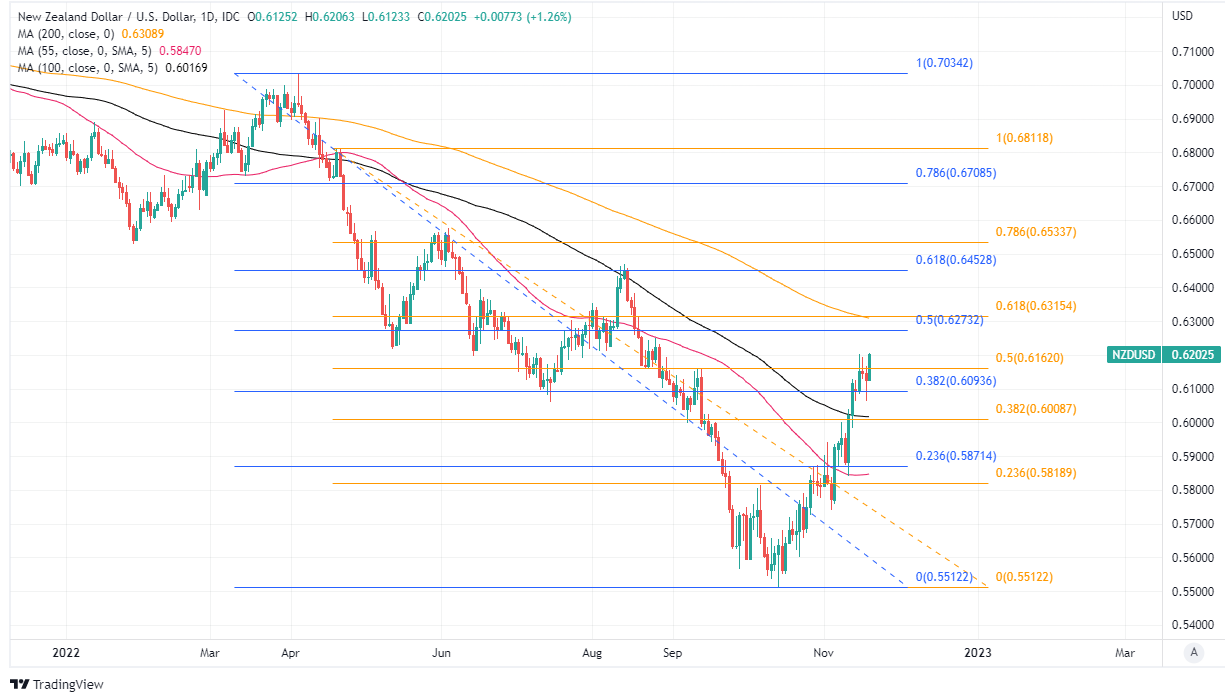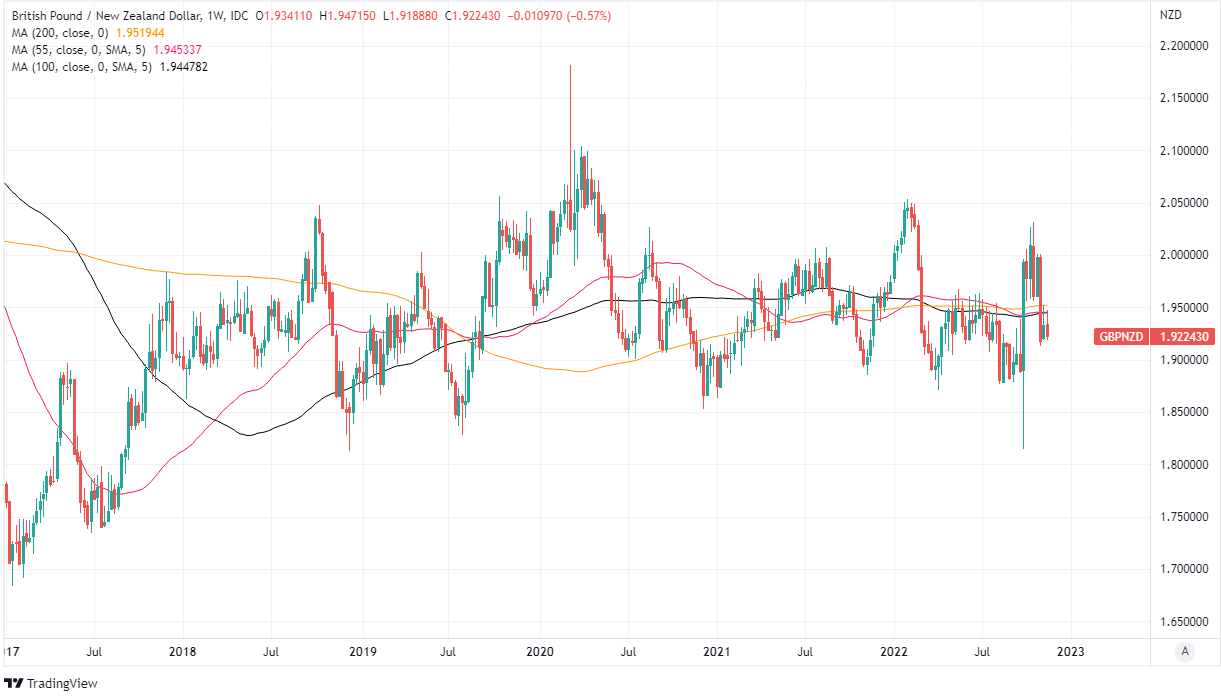Brighter New Zealand Dollar Outlook Another Headwind for GBP/NZD
- Written by: James Skinner
-
- GBP/NZD subdued by cocktail of UK, NZ & global factors
- Any reopening in China could aid a resilient NZ economy
- As unravelling UK consumer economy poses risk to GBP

Image © Adobe Stock
The New Zealand Dollar has climbed to become the best performing major currency of the week and month following a volley of favourable financial and economic developments which could be likely to ensure that any rebounds in GBP/NZD remain short-lived.
New Zealand's Dollar rose against all G20 counterparts on Friday to cement its grip on the top spot in the major currency league table for the week as well as month to mid-November following broad gains for stock markets and a mixed performance from U.S. Dollar pairs ahead of the weekend.
There was no obvious catalyst for Friday's strength though the overall outperformance by the Kiwi dates back to roughly mid-October and point at which official figures began to suggest New Zealand's economy has been more resilient to a multitude of pressures than many had expected.
"Unlike some of the other central banks that we cover there hasn’t been a dovish pivot from the RBNZ and we don’t expect one next week either," writes Kristina Clifton, a senior economist and currency strategist at Commonwealth Bank of Australia, in a Friday look at the week ahead.
 Above: NZD/USD shown at daily intervals with Fibonacci retracements of April 2022 sell-offs indicating possible areas of technical resistance for the Kiwi and shown alongside selected moving-averages. Click image for closer inspection.
Above: NZD/USD shown at daily intervals with Fibonacci retracements of April 2022 sell-offs indicating possible areas of technical resistance for the Kiwi and shown alongside selected moving-averages. Click image for closer inspection.
"Our colleagues at ASB expect an increase of 75bp sending a signal that the RBNZ is determined to push elevated NZ inflation back into the 1‑3% inflation band over time. The arguments in favour of a 75bp hike are strong," she adds.
Statistics New Zealand data suggested on October 11 that Kiwi retail spending had grown strongly during the third quarter, seemingly vindicating the Reserve Bank of New Zealand (RBNZ) for its ongoing aggressive increases in the cash rate, which is widely expected to be lifted from 3.5% to 4.25% next week.
That would see the Kiwi offering the highest interest rate in the G10 currency arena already but some economists also expect the RBNZ to raise its forecast or assumption for how high the cash rate will need to be lifted to bring the Kiwi inflation rate back to within the one-to-three percent target band.
"Amid the ebb and flow, there is greater confidence in the market that the USD has peaked, and that might keep the NZD [NZD/USD] from slipping back below 0.60, especially if the RBNZ’s tone remains hawkish, as we expect. However, things look more mixed technically," says David Croy, a strategist at ANZ.
 Above: Pound to New Zealand Dollar rate shown at daily intervals with Fibonacci retracements of October fall and selected moving-averages indicating possible areas of technical resistance for Sterling. Click image for closer inspection.
Above: Pound to New Zealand Dollar rate shown at daily intervals with Fibonacci retracements of October fall and selected moving-averages indicating possible areas of technical resistance for Sterling. Click image for closer inspection.
All of this is after Kiwi inflation rose by 2.2% during the three months to the end of September and at an annual pace of 7.2% when the RBNZ had assumed a quarterly outcome of 1.4% and annual increase of 6.4% in its August forecasts.
That and the resilient performance of Kiwi economy almost assures a continued hawkish stance from the RBNZ next week but domestic factors are not all that is driving the New Zealand Dollar, which has benefited recently from a correction lower in U.S. Dollar exchange rates and developments over in China.
"The AUD and NZD both stand to benefit from thawing tensions between China and Australia and a part of the recent AUD outperformance is related to that," says Brad Bechtel, head of FX strategy at Jefferies.
"I am not ready to turn bullish on AUD on the China trade issue just yet as I think it will take time to play out and the USD is the main driver for now," Bechtel also said in a Friday market commentary.
 Above: Pound to New Zealand Dollar rate shown at weekly intervals with selected moving-averages indicating possible areas of technical resistance for Sterling. Click image for closer inspection.
Above: Pound to New Zealand Dollar rate shown at weekly intervals with selected moving-averages indicating possible areas of technical resistance for Sterling. Click image for closer inspection.
Recent tweaks to coronavirus-related restrictions in China have encouraged speculation about a possible full reopening of the world's second largest economy at some time next year, which could lift demand for New Zealand's agricultural exports while bolstering the Kiwi economy and currency.
"China’s zero-COVID public health policies remain a key uncertainty for the global outlook. Rumours circulating on Chinese social media in early November suggested a committee had been formed to develop plans for a post-COVID-19 reopening –targeting March 2023 –however this has subsequently been countered by various officials, most notably China’s National Health Commission," cautions Gerard Burg, a senior economist at NAB.
All of the above factors are potentially supportive of the New Zealand Dollar outlook and leave the Kiwi currency standing in contrast to the Pound, which has been burdened significantly in recent months by the direct and indirect effects of this year's increases in energy costs.
Most notably, a fourfold increase in household energy prices has lifted inflation and eaten large chunks of incomes in what is a consumption and service oriented economy while threatening what Bank of England forecasts suggest is likely to be a roughly two year recession.
That anticipated downturn risks being lengthened by a cocktail of planned increases in taxes, cuts to government spending and an incrementally larger impact of rising interest rates at the BoE, the prospect of which does little to encourage an improvement in market appetite for the Pound.





